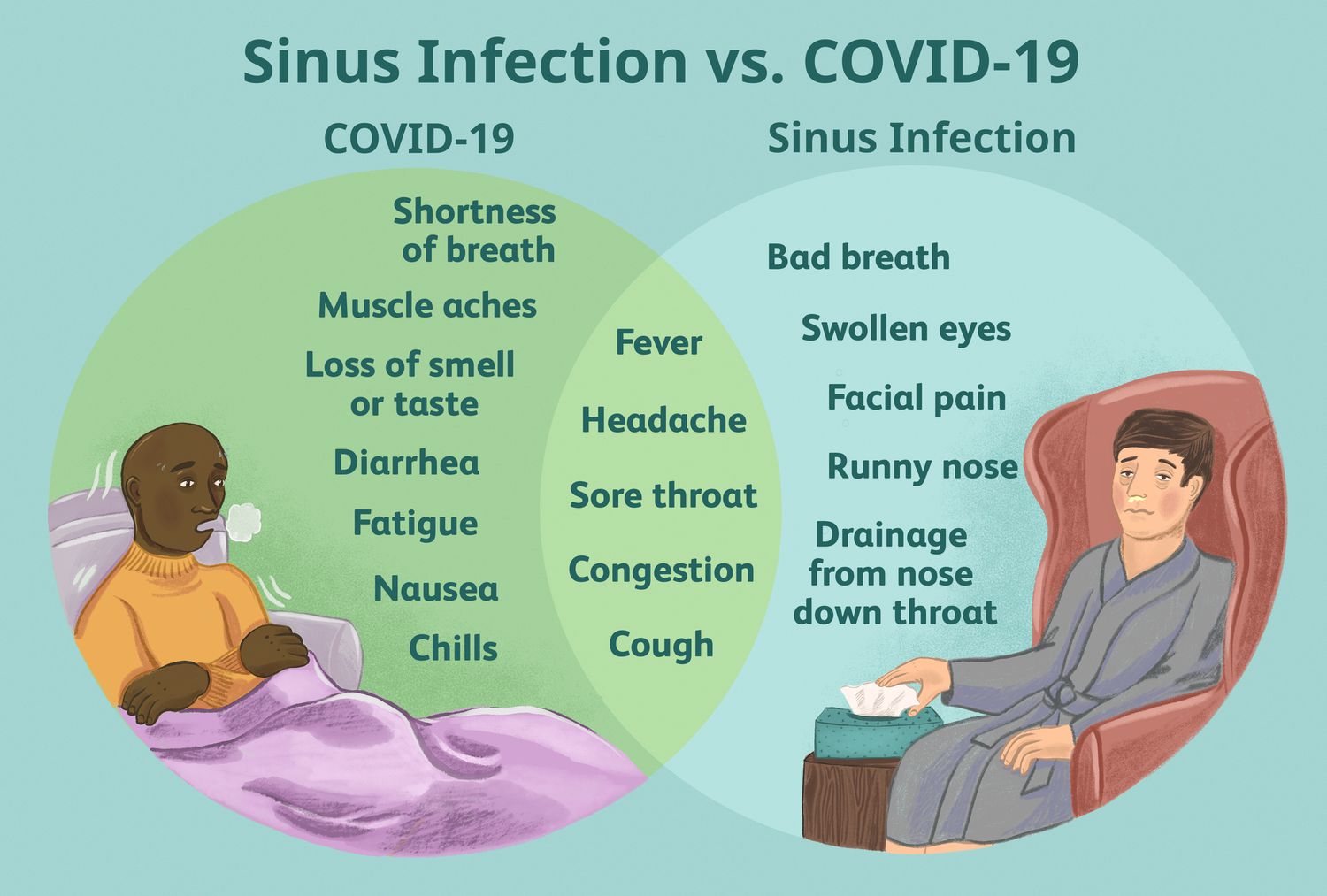Sinus Infections and Colds: A Comparative Guide
When you wake up with a stuffy nose, a sore throat, and fatigue, it’s easy to jump to conclusions. Is it a common cold, or could it be a sinus infection? While these two ailments share some symptoms, they are distinct conditions with different causes, treatments, and potential complications. In this comprehensive guide, we’ll unravel the mysteries of the sinus infection vs. cold dilemma, helping you differentiate between the two and manage your symptoms effectively.

Unraveling the Common Cold
Symptoms of a Common Cold
The common cold, caused primarily by the rhinovirus, is a widespread viral infection of the upper respiratory tract. It’s often characterized by:
Runny Nose:
One of the hallmark symptoms of a cold is a constantly dripping or congested nose.
Sneezing:
Frequent sneezing is common as your body tries to clear the virus from your system.
Sore Throat:
A scratchy or sore throat may accompany a cold, making swallowing uncomfortable.
Duration and Recovery
A typical cold usually runs its course within a week to ten days. Most people begin to feel better within a few days, with symptoms gradually improving.
Exploring Sinus Infections (Sinusitis)
Identifying Sinus Infection Symptoms
Sinus infections, medically known as sinusitis, affect the air-filled cavities in your skull, called sinuses. Symptoms of a sinus infection often include:
Sinus Pressure:
A persistent feeling of pressure around your eyes, cheeks, or forehead.
Sinus Pain:
This discomfort is often intensified when you lean forward or touch your face.
Nasal Congestion:
Similar to a cold, sinus infections can lead to a stuffy or blocked nose.
Types of Sinus Infections
Sinus infections can be classified into two main types:
Acute Sinusitis:
This type typically lasts for a short duration, often as a result of a cold or allergies.
Chronic Sinusitis:
If your symptoms persist for more than 12 weeks, you may be dealing with chronic sinusitis, which requires longer-term management.
Distinguishing Between Sinus Infections and Colds
When you’re feeling under the weather, it’s crucial to distinguish between a sinus infection and a common cold. While some symptoms may overlap, understanding the differences can help you manage your condition effectively.
Duration Discrepancy
One significant difference between these two conditions is the duration of symptoms. A common cold typically lasts for a shorter period, usually a week to ten days. In contrast, a sinus infection, particularly chronic sinusitis, can persist for 12 weeks or longer. If your symptoms endure beyond the typical cold timeframe, it’s essential to consider the possibility of a sinus infection.
Causative Factors
To differentiate between a cold and a sinus infection, consider what triggered your symptoms. The common cold is primarily caused by various viruses, with the rhinovirus being the most common culprit. On the other hand, sinus infections are often secondary to other conditions, such as allergies, nasal polyps, or respiratory infections.
Symptoms That Both Sinus Infections and Colds Share
While there are distinct symptoms for each condition, there are also shared symptoms that can lead to confusion. Understanding these overlapping symptoms can help you better assess your situation.
Congestion and Nasal Issues
Both sinus infections and colds can lead to nasal congestion, making it challenging to breathe through your nose. You may experience a runny or stuffy nose in both cases. This shared symptom can make it difficult to determine the precise cause of your discomfort.
Throat Irritation
Sore throats are not exclusive to colds. They can also occur with sinus infections. The irritation in your throat may feel similar, whether you have a cold or a sinus infection. However, the underlying causes and accompanying symptoms can provide important clues.
Symptoms Unique to Sinus Infections
Sinus Pressure
A distinctive symptom of a sinus infection is the feeling of pressure or fullness in your face, particularly around your eyes, cheeks, or forehead. This discomfort can range from mild to severe and is often exacerbated when you lean forward or touch your face. This sensation is less common in colds and can serve as a key indicator of a sinus infection.
Sinus Pain
If you experience pain in your sinus areas when you have a cold or an infection, the location and intensity can offer valuable insights. Sinus pain due to an infection often feels deep within your face and can be intense, sometimes radiating to your teeth or ears. In contrast, cold-related discomfort is typically milder and more superficial.
Types of Sinus Infections
Acute Sinusitis
Acute sinusitis is typically a short-lived condition, often triggered by a cold or allergies. It results in inflammation of the sinuses and may lead to symptoms such as facial pain, congestion, and a yellow or green nasal discharge. While the symptoms can be uncomfortable, acute sinusitis often resolves within a few weeks with appropriate care.
Chronic Sinusitis
Chronic sinusitis, as the name suggests, persists for an extended period, typically more than 12 weeks. This condition may be caused by structural issues like nasal polyps, a deviated septum, or recurring infections. Symptoms of chronic sinusitis can be similar to acute sinusitis but are more prolonged and may require ongoing management.
Differentiating and Managing Symptoms
As you assess your symptoms, remember that it’s essential to seek a healthcare professional’s guidance if you have concerns about your condition. Accurate diagnosis and appropriate treatment are crucial, particularly if you’re dealing with chronic sinusitis or severe cold symptoms.
FAQs About sinus infection vs. cold
Q: What are the main differences between a sinus infection and a cold?
A: Sinus infections are often caused by bacteria, while colds are typically caused by viruses. Sinus infections may also last longer and involve symptoms like facial pain.
Q: Can a cold turn into a sinus infection?
A: Yes, a cold can sometimes lead to a secondary bacterial sinus infection, especially if it lingers for an extended period.
Q: How can I relieve sinus pressure and pain?
A: Over-the-counter pain relievers, saline nasal irrigation, and warm compresses can help alleviate sinus pressure and pain.
Q: Is it necessary to take antibiotics for a sinus infection?
A: Antibiotics are prescribed for bacterial sinus infections. Viral sinus infections, like colds, do not respond to antibiotics.
Q: Can sinus infections be chronic?
A: Yes, chronic sinusitis can persist for more than 12 weeks and often requires a combination of treatments, including addressing underlying causes.
Q: What is the best way to prevent colds and sinus infections?
A: Regular handwashing, vaccination, and maintaining a healthy lifestyle with balanced nutrition and exercise can reduce the risk of both conditions.
Q: When should I consult a healthcare provider for my symptoms?
A: Seek medical attention if you have a high fever, severe facial pain, or if your symptoms worsen or persist beyond the typical duration.
Q: Are there any natural remedies for managing sinus infection symptoms?
A: Yes, saline nasal irrigation, steam inhalation, and staying well-hydrated are natural approaches that can provide relief.
Q: Can children get sinus infections, or is it more common in adults?
A: Children can get sinus infections, but they are more common in adults due to factors like allergies and structural issues.
Q: What is the role of antihistamines in managing cold and sinus infection symptoms?
A: Antihistamines can help relieve symptoms like runny nose and sneezing by blocking histamines, but they may not be suitable for everyone. Consult a healthcare provider for guidance.
Conclusion:
In conclusion, sinus infections and colds are common respiratory conditions that, while sharing some symptoms, are distinct in their causes, durations, and treatment approaches. Typically caused by viruses like the rhinovirus, colds are short-lived and last for about a week to ten days. Symptoms often include a runny or stuffy nose, sneezing, and a sore throat. Rest, hydration, and over-the-counter remedies can help manage symptoms.




